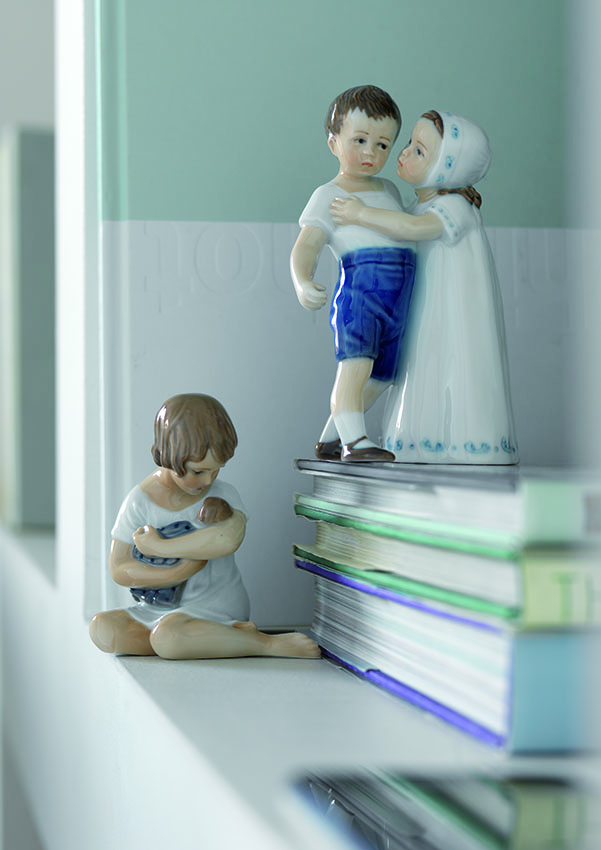
The story of the porcelain factory Bing & Grondahl (also known as B&G)
On request and initiative from the figurine maker Frederik Vilhelm Groendahl (FVG) and the two book and art dealers, the brothers Meyer Herman Bing and Jacob Herman Bing, Bing & Groendahl was founded on April 19th 1853.
A modern factory building was built on Vesterbrogade 149 (Copenhagen, Denmark) - at that time outside the city. Frederik Vilhelm Groendahl used to work for the Royal Copenhagen Factory, but resigned when Royal Copenhagen refused to produce bisquit-figurines modelled from the sculptures of Thorvaldsen.
The factory had big advantages in marketing as Bing & Son (the bookstore owned by the Bing family) already had representatives travelling all over the country. Now they brought along the Bing and Grondahl products. It thus became possible for the entire population to buy tableware and porcelain figurines for the first time.
The representatives brought along blank models of all the porcelain service sets as well as hand painted decoration books. People could then choose the service set and combine it with the decoration pattern of their choice. When the representative returned the following year he brought along the new dinner and/or coffee set.
A fateful loss
A fateful loss was dealt to the factory in 1856 following the sudden death of Frederik Vilhelm Groendahl only 37 year old. Fortunately the overpainter Andreas Juel, former pupil of the empire-architect G. F. Hetsch, had the capacity to lead Bing and Grondahl safely through the initial difficulties.
Initially the factory had a big production of dinner and coffee sets with flowers - many different flowers in various colours, painted polychromatic. The style was known as Saxon flower. The porcelain painters, immigrating from Nürnberg, Germany especially, were specialists in exactly this technique.
Bing & Grondahl acquired knowledge of the underglaze painting technique in various nuances by 1886. The advantage of the underglaze technique, which the factory had used all along, was that the decoration was protected by the glaze, thus not being as exposed to wear and tear as the overglaze-decorations. Moreover the patterns could be painted directly on the item right after the first burn. Hereby reducing the number of burns to two, thus saving time as well as money. A further advantage was the different glow and gloss in the colours.
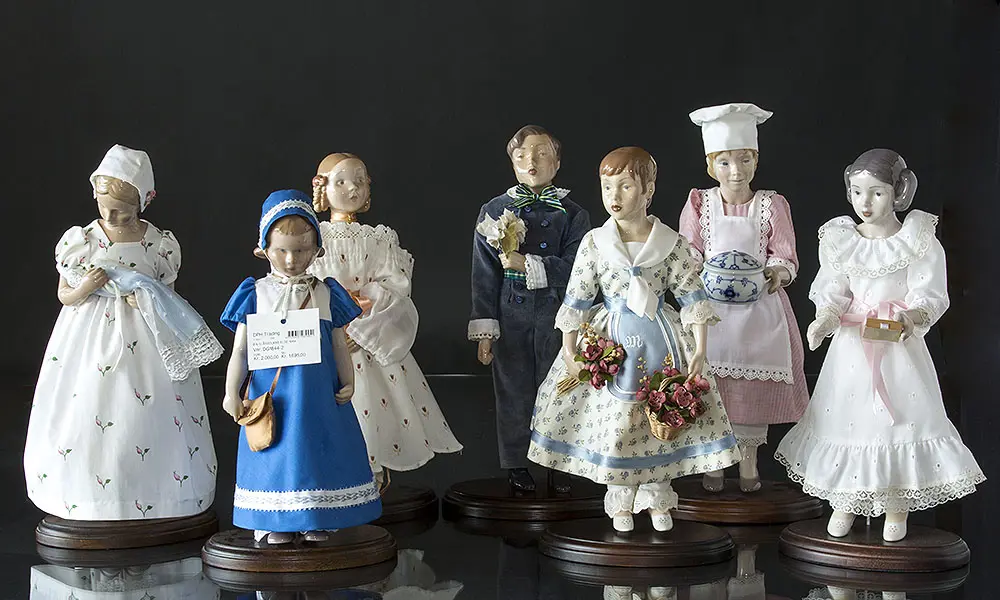
New service sets and an increase in popularity
By 1860 Bing & Groendahl introduced the service set "Don Juan". A handsomely swung round shapes with decorations in red, yellow and gold. The set was renewed with re-shaped coffee cups done by Ebbe Sadolin in 1948 to 1952.
Having existed only nine years Bing & Grondahl participated in the World Exhibition in London in 1862. Christian Hansen contributed with the "Oldenburg" service and Heinrich Hansen with a Coffee set in the Renaissance style of Christian the 4th. The Exhibition brought succes including the vases and bisquit figurines. The same year Heinrich Hansen introduced the Offenbach coffee-set, which became so popular that it was later also made as a dinner set. The "Offenback" was given to Christian the 10th and Alexandrine at their wedding in 1898, and it was therefore also called the "Crownprince-service".
The painter Heinrich Hansen was artistic leader from 1868 - specializing in interior pictures. Heinrich Hansen created a beautifully decorated service set with gold and flowers for "The Scandinavian Exhibition" in Copenhagen (1872). He called it "Rosenborg", because he had been greatly inspired by a Meissen-set that he had seen at an exhibition at the Rosenborg Castle.
A new shop and the bluepainted service
A shop was opened at Amagertorv in 1885 - right next to the Royal Copenhagen factory. The shop was situated here for 100 years, after which it was closed when Bing & Groendahl merged with Royal Copenhagen in 1987.
Blue fluted porcelain was painted from 1886. Royal Copenhagen had the rights to the "Blue Fluted" name, so Bing & Groendahl used the name "Blue Traditional". Originally it was painted on ribbed porcelain, but later it was also available on the popular new service with dolphins and seahorses as handles on sauce boats and tureens.
Pietro Krohn (educated at the Royal Academy of Art) was artistic leader at Bing and Grondahl from 1885 to 1892. During The Northern Exhibition in 1888, Bing & Groendahl exhibited a new service with scales, which has been very popular ever since and the base of many service decorations today. At the same exhibition, the "Heron" service was launched - attracting much attention. The service set was produced exclusively in underglaze with gold - a foretaste of the new "Art Noveau" style. The service was simply made to show off the peak of Bing & Groendahl's artistic and technical abilities.
As with Royal Copenhagen's Flora Danica, The Heron service is considered a masterpiece of Bing & Groendahl. The shape as well as the decoration was considered almost revolutionary. The Heron was also exhibited at the World Exhibition 1889 in Paris, where parts of the service was immediately bought by museums and private collectors from all over the world.
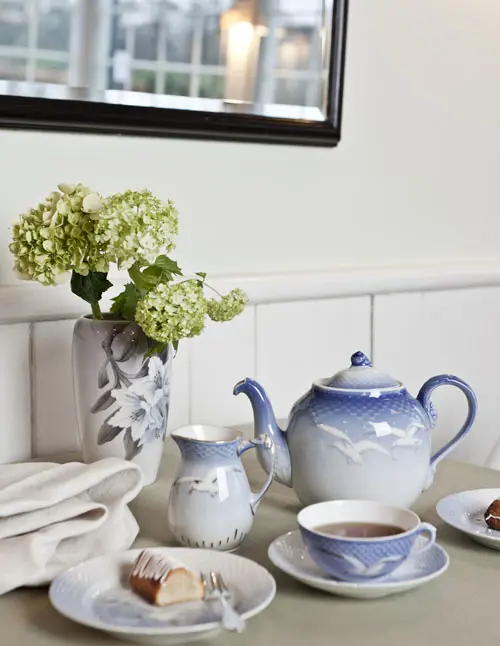
Two amazing female artists
To decorate the Heron service, the two female artists Fanny Garde and Effie Hegermann-Lindencrone were engaged. Pietro Krohn had taught both women at "The Klein Industrial Drawing and Art School for Women". They were both engaged as decoration painters, but as time went by they personally designed new models that they wanted to decorate.
The two women had a close co-operation, sharing the same studio, and they later lived and travelled together. Effie Hegermann-Lindencrone worked for Bing & Groendahl for almost 60 years and created sculptures and vases with her own technique where the flowers, leaves, vines, and animals were cut in raw porcelain mass. With time the technique became so refined that one could see shadows on the surfaces of her work.
Fanny Garde also created vases in a similar matter and when you see the two artists work site by site it can be difficult to tell them apart.
The "Butterfly" service was introduced in the late 1880's. Like the blue painted service, this was produced in various versions. With a golden edge it was called "Kipling" and with blue scales it was called "Dickens".
Designed by Fanny Garde the "Seagull" service was introduced in 1892. The coffee and dinner set was an expression of Fanny's discreet "Art Noveau" style. A few generations later it was given the name "National Service of Denmark" as it was to be found in every tenth home throughout the country and was used in one out of ten homes.
The first Christmas plate
By idea of Harald Bing, son of Jacob Herman Bing, the world's first Christmas plate "Christmas Eve" was produced at Bing & Grondahl in 1895. The plate was designed by F. A. Hallin.
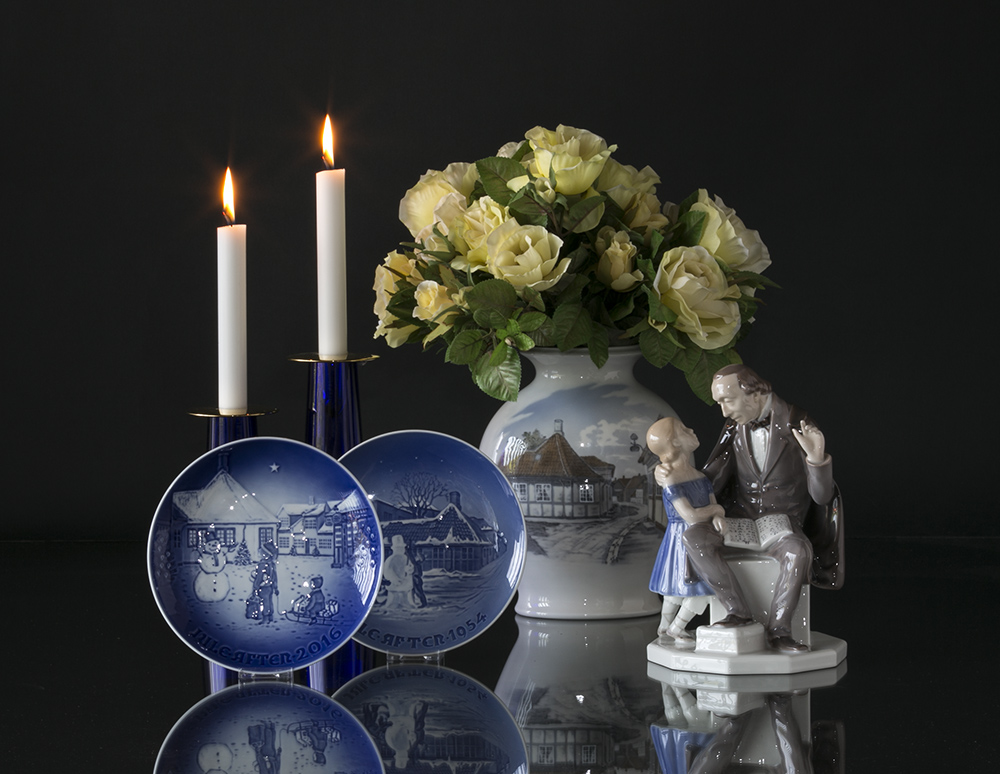 Cautiously Bing & Groendahl started out with a very small production of this very first plate. When it showed to be a big sales success, plate productions were started throughout the world including at Royal Copenhagen. Thus this first plate set the fashion of the global interest in collectibles. It became a worldwide craze and all the manufacturers in the world as well as organisations produced or had plates produced for any occasion.
Cautiously Bing & Groendahl started out with a very small production of this very first plate. When it showed to be a big sales success, plate productions were started throughout the world including at Royal Copenhagen. Thus this first plate set the fashion of the global interest in collectibles. It became a worldwide craze and all the manufacturers in the world as well as organisations produced or had plates produced for any occasion.
Not even Bing & Groendahl themselves know exactly how many have been produced through the years, as much material was lost during a fire in their archives.
No other manufacturer has produced as many plates as Bing & Grondahl. Just to mention some, Bing & Groendahl has produced King Plates, Christmas Plates, Easter Plates, Mothers Day Plates, Airplane Plates, Ship Plates, Logde Plates, Olympic Plates, Jubilee amd Commemorative Plates, Church Plates, and many other kinds of plates.
In 1897 the sculptor Axel Locher started at Bing & Grondahl. In close co-operation with Willumsen, he created several monumental vases, such as The Wood Cutter vase (Fall).
The Three Towers
As a trademark Bing & Grondahl chose "The Three Towers" in 1898 - an ancient symbol of Copenhagen, originating from Absalon's Castle. This is the same symbol used in the Copenhagen City Arms. (Bishop Absalon founded Copenhagen in 1167). The brand has been used with several different inscriptions through the years.
New artistic leader and a growing interest for stoneware
Successor of Pietro Krohn was J. F. Willumsen, engaged as artistic leader in 1897 to 1900. Despite the fact that he only modelled one figurine during his entire engagement - namely "The Bathing Boy"(now placed at the ceremonial hall at the Copenhagen City Hall), he was continuously a huge inspiration to the workers and artists of RC.
J. F. Willumsen made numerous experiments with multi-colours and arranging white and coloured surfaces along each other. He discovered the metallike ironoxide-glaze varying from deep ironed to light bronze.
During the leadership of Willumsen Svend Hammershoj also worked at the factory primarily making vases. J. P. Dahl Jensen was hired in 1897, too. He was a modelling master from 1897 to 1917 modelling several figurines on behalf of Bing & Groendahl.
Willumsen was hired to secure a success at the Paris World Exhibition 1900. Exactly this exhibition gave Bing & Grondahl the international breakthrough they had hoped for.
Although the period with Willumsen were prestigious, earnings were not good. A few years after his resignation, the factory worked without an artistic leader, but strangely those are the years, when the B&G financial foundation was created. The Dahl Jensen underglaze figurines of birds, animals and people, as well as the Seagull, the Butterfly, the Empire and the Bluepainted service sets were the basis of the Bing & Grondahl finances.
In the beginning of danish porcelain production, only men were hired in regards to decorations. In the beginning of 1900 the blue painted porcelain was made purely by women. The Empire" service was launched in 1904. It was designed by Harriet Bing, the directors wife.
Architect Carl Petersen was engaged as artistic consultant in 1912. He had a strong passion for stoneware, the shapes, ornaments and glazes that the stoneware caused.
The well known Knud Kyhn created his first stoneware figurine - a duck - on behalf of Bing & Groendahl in 1913. Kyhn had a predilection for animal life, especially birds. He made a lot of both underglaze and overglaze figurines and sculptures for Bing & Groendahl (and later on also for Royal Copenhagen). His probably most known for his big, dark brown stoneware figurines of bears, elephants, and so on.
The subsidiary "Norden" and new materiales
"Norden", a subsidiary of Bing & Groendahl, was founded in 1916. It produced porcelain parts to be used in the rapidly expanding electricity market. The products ranging from telegraf insulators to electricity bells. This enterprise further consolidated Bing & Grondahl's economy. As the first general manager of "Norden" Dahl Jensen was engaged from 1917 to 1925.

The Frenchman Jean René Gauguin was employed by Bing & Grondahl for a long period. He started in October 1923 as a permanently employed artist, creating unglazed porcelain and stoneware sculptures. Most reputed is probably his many sculptures in the special stoneware mass that he called "Roche Céramique". Moreover he was the first to introduce faience at Bing & Groendahl. In 1927 he created 10 expressionistic giant sculptures representing animals and people. His brother Pola did the enamel decorations of the sculptures.
Experiments in "Soft" porcelain was done by Axel Salto during the years 1923-1925. The delicate subdued glazes gave the products a silk-like expression. Today Axel Salto's design has risen in popularity and it'is being sold at a high price.
In the same period of time, the sculptor Kai Nielsen was also engaged in the factory. He created 40 models of porcelain figurines in that period before his unexpected death in 1924.
The wild and original unglazed porcelain figurines from Gaugain's hand was among the news at Bing and Grondahl's exhibition at the Paris World Exhibition 1925. Also displaying the sculptured Kai Nielsen figurines in white porcelain as well as Axel Salto's soft porcelain and stoneware. The exhibition granted Bing & Groendahl big artistic and economic success as well as international attention. Moreover, the exhibition resulted in a collaboration with craftsman Ebbe Sadolin.
A collaboration with Ebbe Sadolin
Ebbe Sadolin was very inventive in designing figurines, vases, service sets etc.. He was permanently engaged two years after the exhibition. His specialty was the shapes. He left decorations to others, except for the glazing of relief patterns. Ebbe Sadolin experimented with colours, gloss and dispersion, when used on relief products and quickly developed a preference for dull glazes.
The work involved in designing and creating a service set is extensive and expensive, none the less Ebbe Sadolin designed a number of service sets for Bing & Groendahl in the 1940s, for example the "Lovfald" and the "Demeter", painted with decorations by Ove Larsen.
His service "The Milky way" was introduced in 1942. It was decorated with brown lines and a golden rim and the surface was sprinkled with small gold stars. The famous "Bodil" statuette, awarded each year to outstanding danish movie actors and directors, was created by Ebbe Sadolin.
Ebbe Sadolin had a major influence on the development of Bing & Groendahl. He stayed with the company, but from the mid-thirties he also engaged in illustrating magazines. In 1977 he celebrated his 50th anniversary with Bing & Grondahl.
A different and more versatile leader and a new era for stoneware
In 1930, when Kay Bojesen, originally trained as a silversmith at Georg Jensen, became artistic leader at Bing & Groendahl, he made radical changes. Between 1930-31 he drew a mocca service and a coffee service, created glass for Holmegaard Glass, as well as knives, and so on. He was a different and versatile leader of Bing & Groendahl. After his departure from the factory he went on to create his world famous production of figurines in tree, such as the monkey, horses and elephants, and so on.
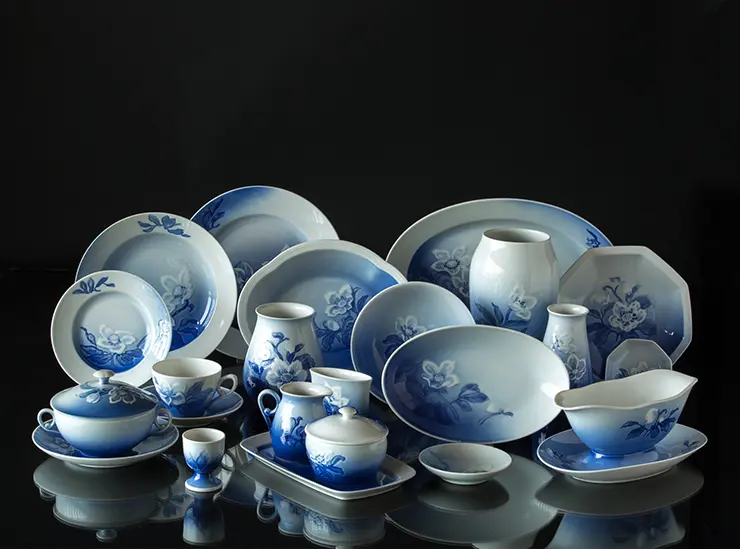
"The Christmas Rose dinnerware" was presented in 1936 designed by Cecilie Louise Hallin and her husband F. A. Hallin (the designer of the world's first Christmas plate "Christmas Eve".).
At request of artistic consultant Aksel Rode, Gertrud Vasegaard, a ceramic artist and daughter of Hans Adolph Hjorth (Hjorth's Factory, Ronne), was engaged for "guest performances" at Bing & Grondahl during the winter months of 1945 to 1948, while working at her own workshop in Gudhjem the rest of the year. This double life ended in 1949, when she became part of the permanent staff.
Her specialty at Bing & Grondahl became the stoneware. Aksel Rode developed a number of new glazes especially for her. Her unique ceramic talent was displayed and she became very significant to the future of the factory. The style, she fostered, began a new era in the history of stoneware. Her engagement at Bing & Groendahl lasted for 10 years, after which she started a workshop in cooperation with her daughter Myra and Aksel Rode, who had then become her husband.
The post-war period
In 1961 the factory employed Erik Magnussen on the request of artistic consultant Asger Fisher (Manager of "Den Permanente"). He became the big innovator and developer of design and products up through the 60's and 70's.
Through his pottery background and his technical sense he had the gift of designing for production. It was in his nature to create functional and simple things extremely suitable for their purposes. EM startet out by designing the"Form 679" service only including 11 pieces, the selection was cut down to an absolute minimum. Later the "Hank" service followed including 18 pieces. This was his first production with other colours than white.
In the figurative language of the post war years, it was said in the 1920's that in the mutual relationship between Bing & Grondahl and The Royal Porcelain Factory sold to the madams in furs, whereas Bing & Groendahl sold to the university graduates in fleece coats.
The primary customers of The Royal Porcelain Factory were still the Royal family and the upper middle class, whereas Bing & Grondahl sold to the intelligentsia. Although the core business of Bing & Groendahl was bisquit figurines, they continuously produced a wide selection of figurines, plates and service sets. Their production quickly grew very extensively.
To survive in competition with The Royal Porcelain Factory, Bing and Grondahl soon realised that to engage with the leading artists and designers of the time paid off. This attitude has been characteristic of Bing & Grondahl throughout the entire existence of the factory. This attitude was displayed in the stoneware production initiating around 1912.
The artists were given extremely free hands and Bing & Groendahl deliberately concentrated on providing a creative and stimulating artistic environment. No questions were asked as to whether a product or an experiment was worthwhile. Potential results were just awaited calmly.
The great merge
Bing & Groendahl merged with The Royal Porcelain Factory in 1987, after which the mutual name became Royal Copenhagen. When the two factories became Royal Copenhagen, Bing & Grondahl had the largest earnings of the two with major exports, primarily to Sweden.
For instance Bing & Grondahl was Royal purveyor to the King of Sweden. Yet the Bing & Grondahl name disappeared almost immediately after the merger.
Today the illustrious name only lives on in plates and other collectibles being released every year mainly around Christmas. All other products originally manufactured by Bing & Groendahl and still in production, are now stamped with the Royal Copenhagen hallmark.
It is difficult to establish which product was originally manufactured by which factory. Bing & Grondahl has through the years been Royal purveyors to Russia, Sweden, Denmark and Great Britain. In Denmark and the US the factory has been known to produce porcelain and figurines of a quality just as good as Royal Copenhagen.
In most of the world the knowledge of Bing & Grondahl is very limited as Danish porcelain is synonymous with Royal Copenhagen to most people. Royal Copenhagen is the name under which The Royal Porcelain Factory has always been marketed internationally, so many foreigners have never heard about B&G. Additionally both factories have been marketed under the Royal name since the merger. The Japanese especially, who are also royalists, and who did not purchase Danish porcelain until the late 90's, buy Royal Copenhagen exclusively.
Facts about Bing & Grondahl:
Where is Bing & Groendahl from?
- B&G is the Danish Porcelain factory Bing & Grondahl.
When was Bing & Groendahl established?
- Bing & Grondahl was established in 1853 in Copenhagen, Denmark.
What does the 3 towers in the Bing & Groendahl trademark mean?
- The three towers of the Bing & Groendahl trademark is from the coat of arms of Copenhagen, capital of Denmark.
Which is the most famous Bing & Groendahl dinnerware?
- The most famous dinnerware produced by Bing & Groendahl is the seagull dinnerware, which for a long time was the most common dinnerware in Denmark.
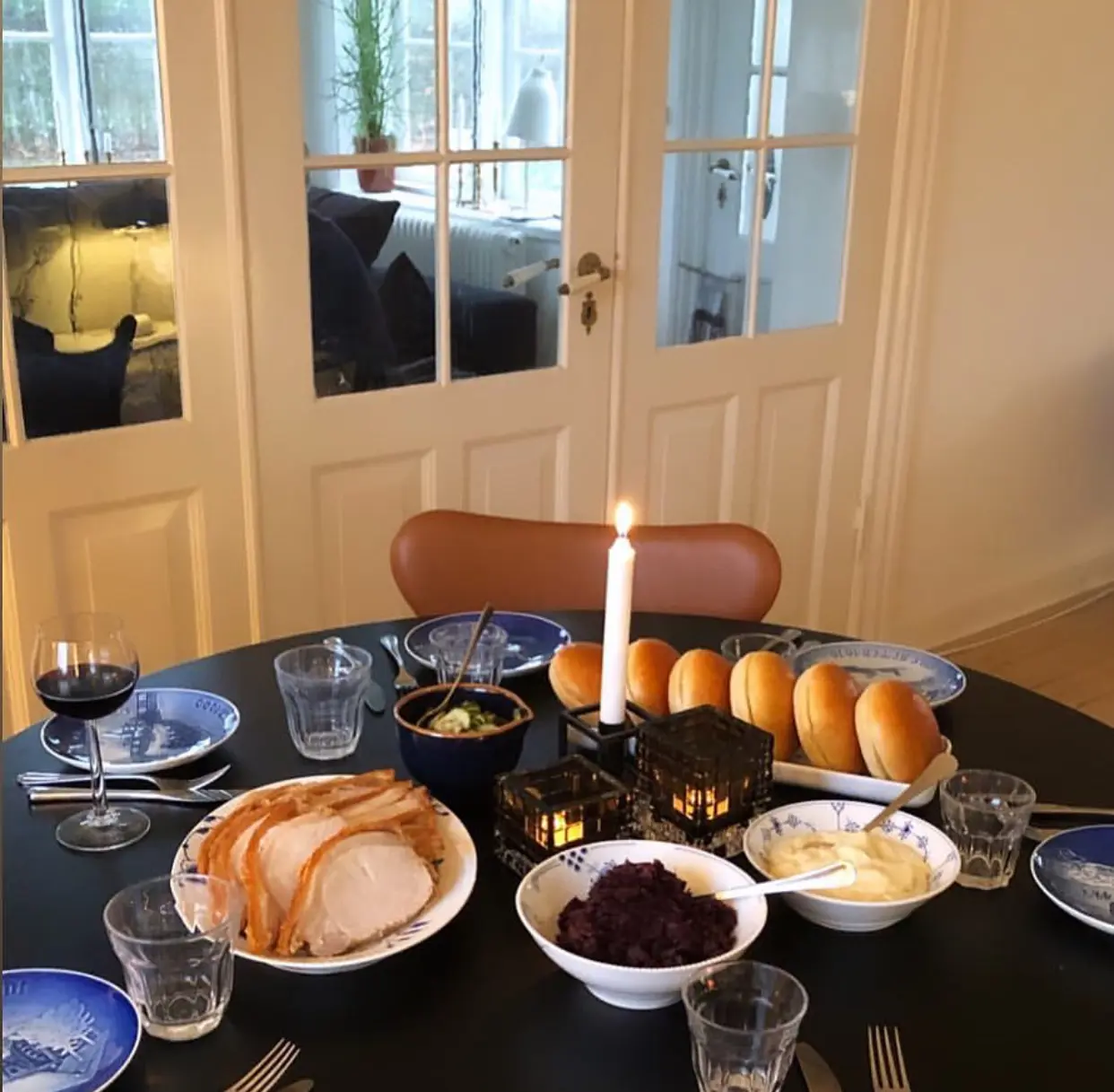
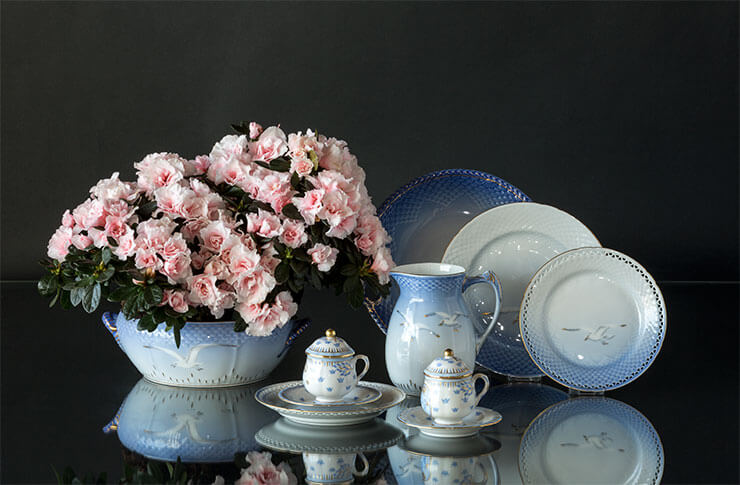
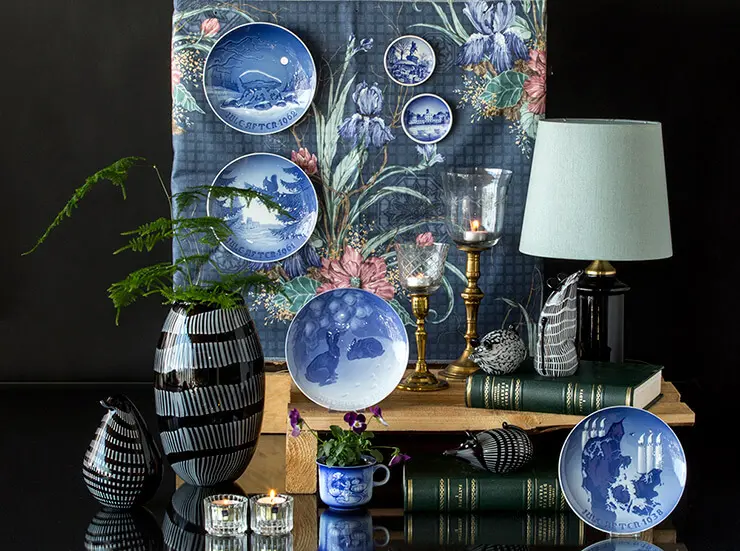
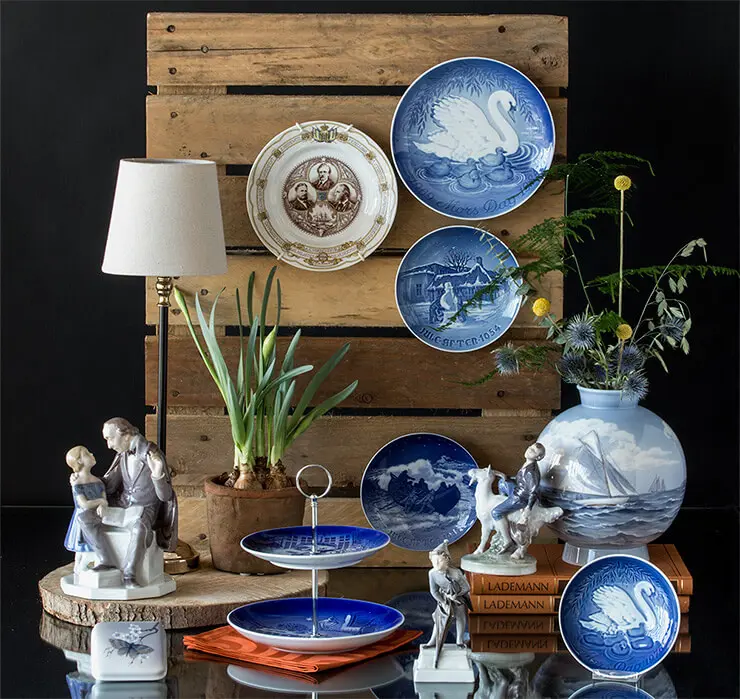
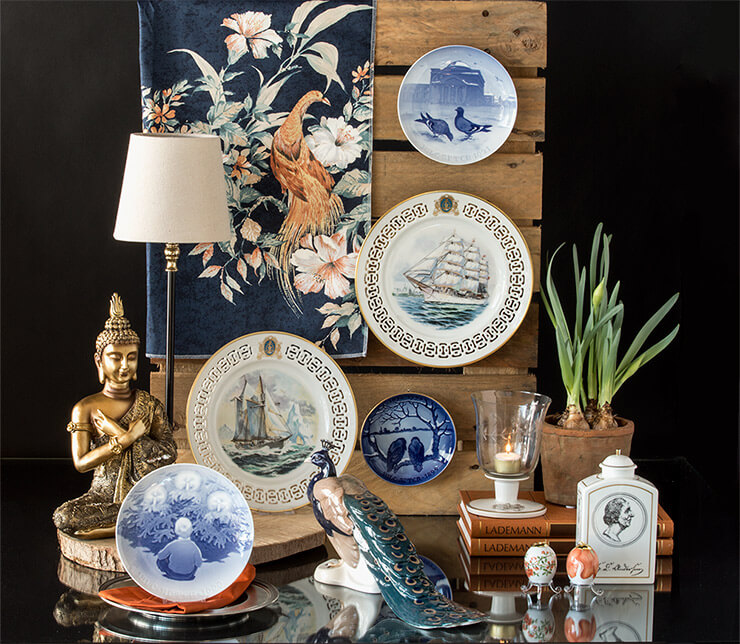
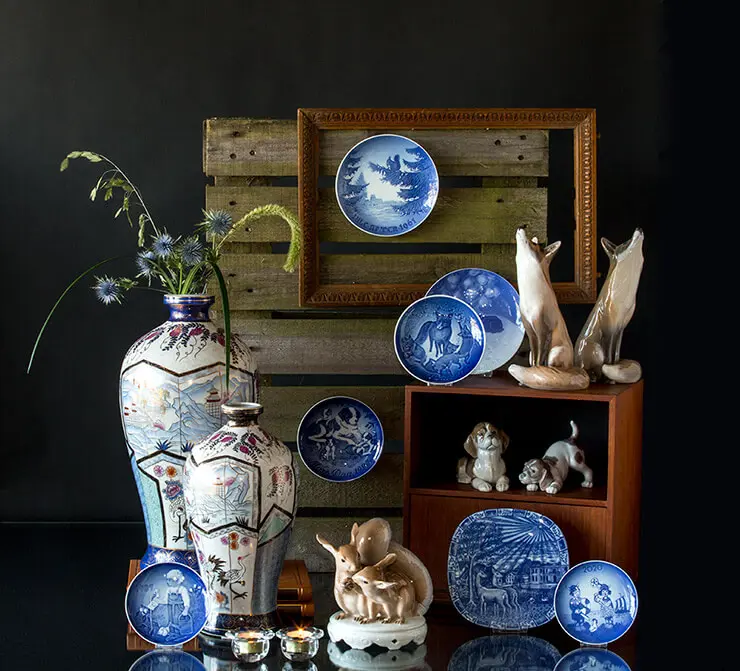
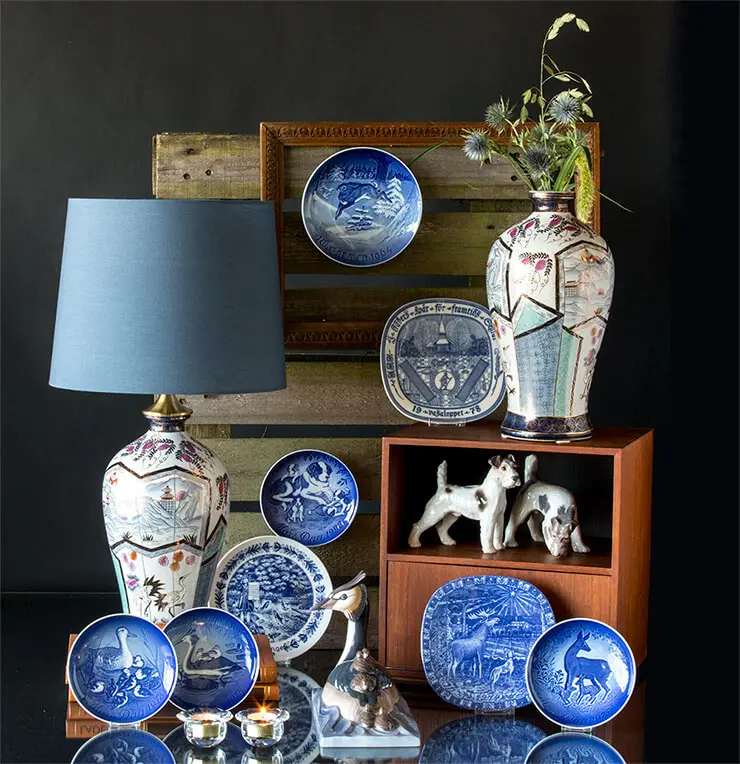
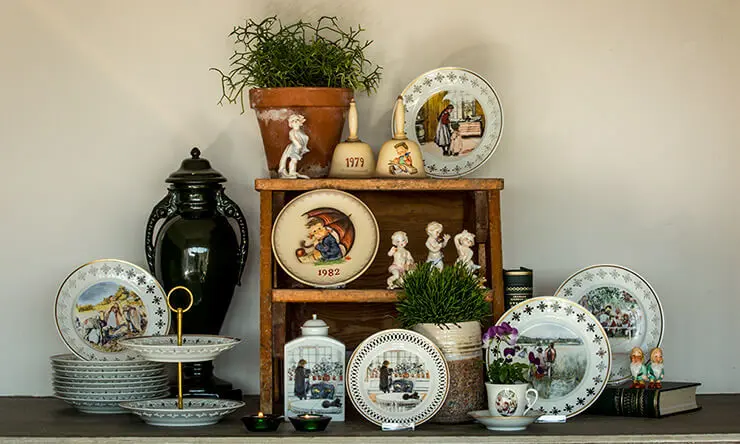
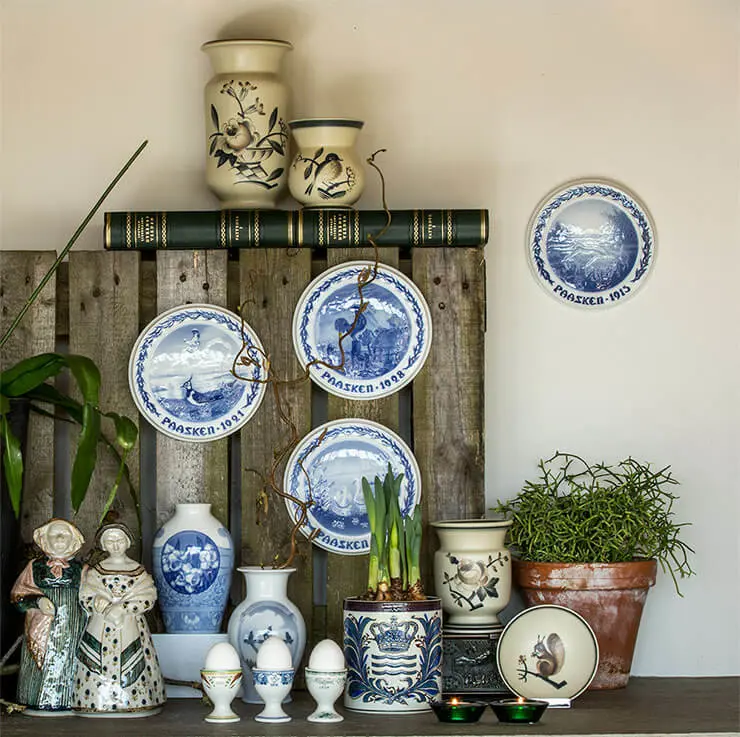


 We are e-approved
We are e-approved





